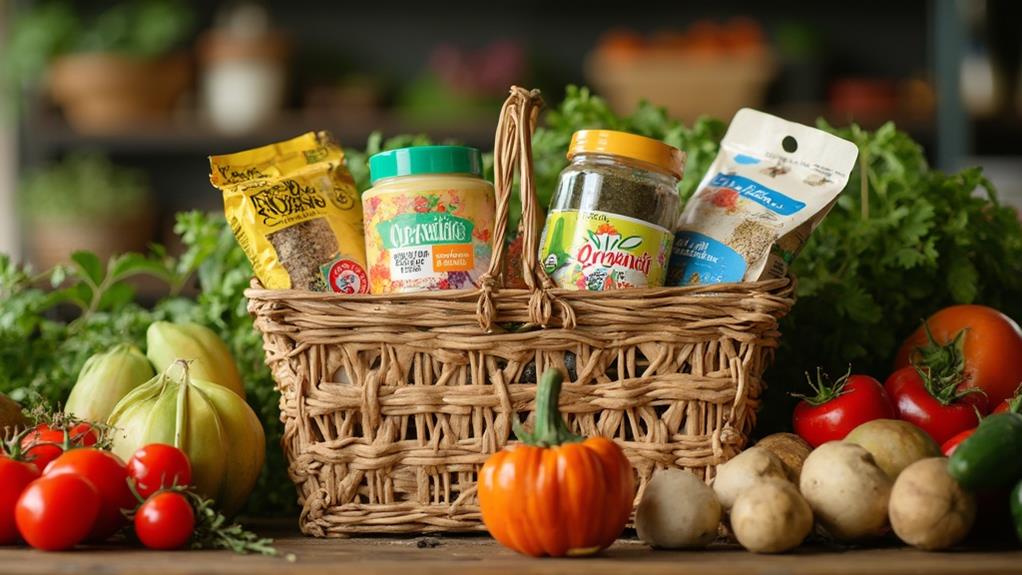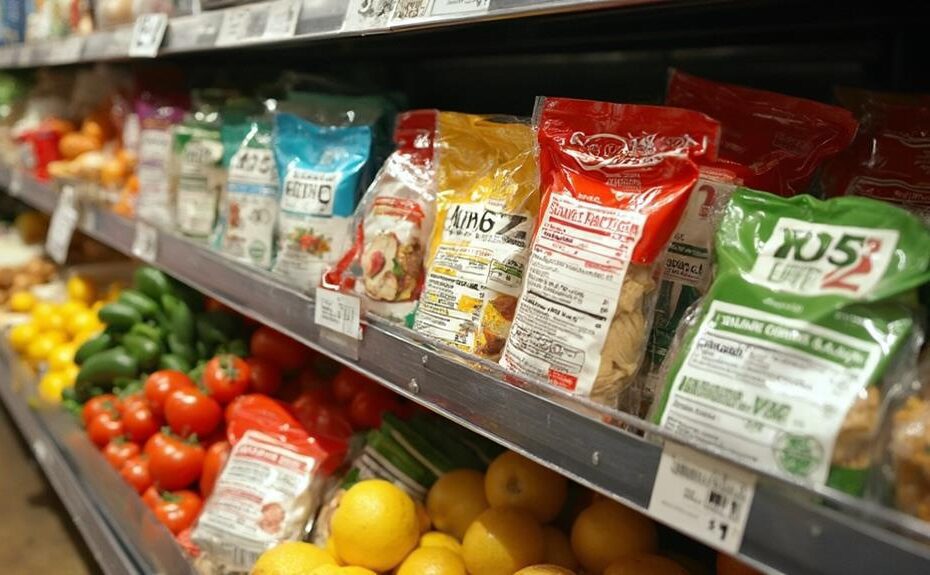Making Healthier Choices with Food Labels
Understanding food labels is crucial for making informed decisions about what you eat. The Nutrition Facts panel is the first place to look. This panel shows the number of calories, fats, carbohydrates, and proteins in a serving of the food.
Pay attention to added sugars, which can be hidden in ingredients like high-fructose corn syrup or honey. Daily Values (DV) percentages help you gauge the nutrient levels in a food, with 5% or less being low and 20% or more being high.
Ingredient Lists Reveal What's Really in the Product
The ingredient list shows the components of the food, with whole foods like fruits, vegetables, and whole grains at the top being the most desirable.
Allergens like peanuts, milk, and soy are typically highlighted to alert consumers with specific allergies. If you're looking for organic or non-GMO options, these labels can indicate fewer chemicals and genetically modified organisms in the food.
By understanding these aspects of food labels, you'll be better equipped to navigate grocery aisles and make healthier choices.
Importance of Food Labels
Food labels are essential for making informed dietary choices. They provide critical information about the nutritional content of food products, allowing for easy comparison between different items.
Understanding food labels helps identify key nutrients, such as vitamins, minerals, and fiber, which are vital for maintaining overall health.
Food labels also help manage dietary restrictions or health conditions. If monitoring intake of sugar, sodium, or fat, labels clearly indicate these amounts, guiding selections.
This transparency empowers individuals to choose foods that align with their health goals, whether aiming to lose weight, build muscle, or simply eat healthier.
Food labels can also inform environmentally conscious choices. Many labels indicate whether products are organic, non-GMO, or sustainably sourced, influencing purchasing decisions based on personal values.
In a world filled with processed foods and misleading marketing, food labels serve as the best resource. By taking a moment to read and understand these labels, individuals equip themselves with the knowledge necessary to navigate their dietary choices wisely.
Key Components of Labels
When examining a food label, it's essential to understand the key components to make informed choices.
Nutrition Facts provide a breakdown of calories, fats, carbohydrates, and proteins.
Pay attention to the amount of added sugars and sodium, as these can impact your health. For example, if a product has high amounts of added sugars, it may contribute to weight gain and increased risk of chronic diseases.
The Ingredient List shows ingredients in descending order by weight.
If whole foods like fruits, vegetables, and whole grains are at the top, that's a good sign. Avoid products with long lists of artificial additives or preservatives, as they may be detrimental to your health.
Allergen Information is crucial for those with food allergies.
Look for common allergens like peanuts, tree nuts, dairy, soy, wheat, and shellfish, often highlighted in bold or a separate box. This information helps individuals with food allergies make safe choices.
Serving Sizes Explained

Serving sizes are a crucial aspect of understanding food labels. They indicate the amount of food typically consumed at one time and serve as a baseline for the nutritional information provided. Serving sizes are usually expressed in common measurements, such as cups or pieces, making it easier to gauge your intake.
Serving sizes aren't recommendations, but rather reflect what people generally eat. They can vary significantly between products. For example, a serving of ice cream might be half a cup, while a serving of chips could be just an ounce.
To manage portion control effectively, always compare your actual serving to the suggested serving size. If you're consuming multiple servings, remember to multiply the nutritional values accordingly.
Understanding Nutrition Facts
Decoding the Nutrition Facts Label
After understanding serving sizes, the next step is to interpret the Nutrition Facts label, which provides crucial information about the food you consume, enabling you to make informed, healthier choices.
Calories
The number of calories in a serving helps you manage your weight. Consuming the appropriate number of calories is essential for maintaining a healthy weight. For example, if you need 2,000 calories per day, a serving of food with 200 calories will account for 10% of your daily caloric intake.
Nutrients
Fats, carbohydrates, and proteins are essential for energy and body function. A balanced diet requires the right mix of these nutrients. For instance, carbohydrates provide energy, while proteins build and repair muscles.
Daily Value Percentages
Daily Value percentages indicate how much a nutrient contributes to your daily diet. These percentages help you determine if a food fits your nutritional needs.
Aim for foods with higher %DV in nutrients you want more of, like fiber, and lower %DV in those you want less of, like saturated fat and sodium. For example, a food with 20% DV of fiber can help you meet your daily fiber needs.
Ingredient Lists Demystified

Understanding Ingredient Lists
Ingredient lists on food packaging reveal the composition of the product, with the first few ingredients being the most significant.
If the top ingredients are whole grains, vegetables, or fruits, the product is likely healthier. On the other hand, if sugar or unhealthy fats dominate the list, it may not be the best choice.
Eco-Friendly Packaging and Waste Reduction
In addition to the ingredients, consider the packaging itself.
Look for eco-friendly packaging made from sustainable materials. Moreover, reducing waste by repurposing materials like coconut husks can have a significant environmental impact.
Additives and Preservatives
Some ingredients can indicate a highly processed product.
Be aware of additives like sodium nitrite or BHA, which may suggest a product is heavily processed.
Opt for items with fewer ingredients or those you can easily recognize for a cleaner diet.
Allergens and Sensitivities
Check for common allergens like nuts, dairy, and gluten, which are often highlighted on the label.
If you have sensitivities, this information is crucial.
Recognizing Added Sugars
Recognizing Added Sugars
Added sugars can enhance food flavor, but excessive consumption contributes to health issues.
To maintain good health, it's crucial to recognize added sugars in your diet. They often hide under different names on food labels, making it essential to know what to look for.
Where to Find Added Sugars
- Sweeteners: Look for sugar, high fructose corn syrup, and agave syrup on food labels.
- Processed Foods: Many snacks, sauces, and dressings contain added sugars that you mightn't expect.
- Beverages: Soft drinks, energy drinks, and flavored waters can pack a sugary punch.
Reading Food Labels
When reading food labels, check the ingredient list for added sugars. The Nutrition Facts panel indicates total sugars, but it doesn't differentiate between naturally occurring sugars and added ones.
Importance of Being Vigilant
By being vigilant about added sugars, you can make healthier choices and reduce the risk of obesity, type 2 diabetes, and heart disease.
Interpreting Daily Values

Understanding Daily Values on Food Labels
Daily Values (DVs) on food labels indicate how much a nutrient in a serving of food contributes to a daily diet, based on a 2,000-calorie daily intake.
When looking at a food label, you'll see percentages next to each nutrient listed, representing the proportion of the daily recommended amount. These percentages show how much of the daily nutrient needs are met by one serving of the food. For example, if a food item has a DV of 20% for calcium, it means one serving provides 20% of the calcium you need in a day.
Interpreting Daily Values
- 5% DV or less is considered low, meaning the food isn't a significant source of that nutrient.
- 20% DV or more is regarded as high, indicating the food is a good source of that nutrient.
Considering Individual Dietary Needs
It's essential to consider your individual dietary needs, as these percentages may not apply to everyone.
Active individuals or those with specific health conditions may require more or less of certain nutrients. Always read labels carefully and adjust your food selections according to your nutritional requirements to meet your health goals and ensure a balanced diet.
How Do Food Labels and Nutrition Information Help Promote Food Security and Nutrition?
Food labels and nutrition information play a crucial role in promoting food security and nutrition by providing valuable details about the contents of the food. The role of government and organizations is vital in ensuring that accurate and easily understandable information is available to the public, empowering them to make healthier food choices.
Allergens and Safety Information
Allergens and Safety Information on Food Labels
Food labels provide crucial information about allergens and safety to help consumers make informed choices.
This information is especially important for individuals with food allergies or specific dietary needs.
Common Allergens
Food labels highlight common allergens to prevent serious health risks.
The most common allergens include peanuts, tree nuts, milk, eggs, wheat, soy, fish, and shellfish, which are usually listed in bold or capital letters.
Cross-Contamination Warnings
Labels may include phrases such as "may contain" or "produced in a facility that processes" to indicate potential cross-contact with allergens.
This information helps consumers assess the risk.
Expiration Dates and Safety Notices
When checking food labels, always look for expiration dates and any safety recalls that may affect the product.
This information ensures the product is safe for consumption.
Organic and Non-GMO Labels

What do organic and non-GMO labels mean?
Organic foods are produced without synthetic pesticides, fertilizers, and genetically modified organisms (GMOs). When you see an "USDA Organic" label, it means at least 95% of the ingredients are certified organic, ensuring you're choosing food grown in a more natural environment.
What is the significance of non-GMO labels?
Non-GMO labels signify that the product doesn't contain genetically modified ingredients. The Non-GMO Project Verified seal is a reliable indicator, as it undergoes rigorous testing to guarantee that GMOs aren't present. This can be especially important for those concerned about the potential health and environmental impacts of GMOs.
What are the benefits of choosing organic and non-GMO products?
Choosing organic and non-GMO products can benefit your health, as these foods often contain fewer chemicals and more nutrients.
Additionally, supporting organic farming practices encourages biodiversity and reduces pollution from synthetic substances.
Is organic always healthier?
Organic doesn't always mean healthier; some organic snacks can still be high in sugars or fats.
Always read the full nutrition label for a complete picture of what you're consuming.
Tips for Smart Shopping
Smart shopping significantly impacts your health and budget. By making informed choices, you can buy nutritious foods and save money. Choose eco-friendly products to contribute to a greener lifestyle.
Read Labels to ensure you're buying healthy foods. Always check the nutrition facts and ingredient lists. Look for whole foods and minimize added sugars and unhealthy fats.
Plan Your Meals to stick to a grocery list and avoid impulse buys. Create a meal plan for the week, and you'll be more likely to buy only what you need.
Buy Seasonal Produce to get fresher and less expensive fruits and vegetables. By supporting local farmers who use sustainable practices, you're promoting environmentally friendly agriculture. For example, buying apples in the fall or berries in the summer is a great way to get fresh produce while saving money.
Compare prices between brands and sizes to get the best value. Larger quantities may offer better value, so don't hesitate to do the math.
Be wary of marketing terms like "natural" or "healthy," as they can be misleading. Instead, focus on whole foods and items with fewer ingredients.
Shopping on a full stomach can also help you resist the temptation of unhealthy snacks. By following these strategies, you'll eat healthier and keep your wallet happy.
